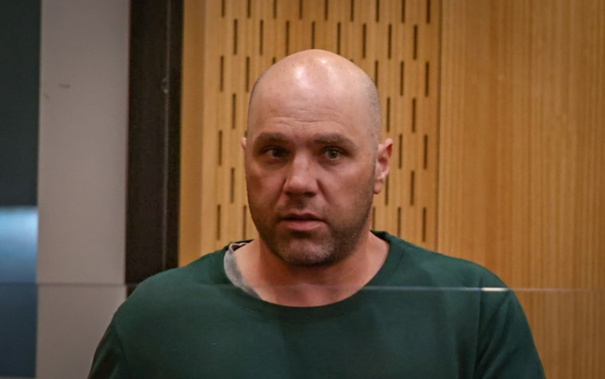
- Paroled rapist Joseph Brider was deemed “high high” risk days before murdering Juliana Bonilla Herrera in Christchurch.
- Brider’s probation officer had concerns about him reoffending and noted potential risks to women.
- Coroner Alexandra Cuninghame is holding an inquest into Herrera’s death and Brider’s management.
Days before he murdered Juliana Bonilla Herrera in her Christchurch home, paroled rapist Joseph Brider was noted to be “high high” risk by his probation officer.
The officer has today revealed that after Brider was released from prison she had “concerns” about him reoffending and noted that “any attractive female moving into the neighbouring flats or next door would be seen as a potential risk”.
Herrera, 37, was found dead in her Addington flat in January 2022.
She had been murdered by her neighbour, Brider.
Brider was a convicted rapist who had been granted parole after previously being refused five times.
 Juliana Herrera died in January after a man allegedly entered her Christchurch home and attacked her. Photo / Supplied
Juliana Herrera died in January after a man allegedly entered her Christchurch home and attacked her. Photo / Supplied
He moved into the unit beside Herrera’s in November 2021 and quickly became obsessed with her.
She told friends he made her uncomfortable and she felt like she was “being watched”.
Brider broke into her home while she was asleep, physically and sexually assaulting her and stabbing her to death.
He was sentenced to life in prison with preventive detention.
Both the Parole Board and Corrections have reviewed how Brider was managed.
Coroner Alexandra Cuninghame is now holding an inquest into Herrera’s death and whether anything could have been done to stop Brider’s fatal actions, or can be done in future to prevent similar tragedies.
Brider’s probation officer was the third witness called.
‘I assessed his risk to females as high’ - probation officer
The experienced probation officer has interim name suppression.
She told the coroner that she manages a range of offenders subject to a variety of community-based sentences and parole conditions.
She was allocated as Brider’s probation officer on October 27, 2021, as she had the experience required to handle his case.
 Coroner Alexandra Cunninghame. Photo / Pool
Coroner Alexandra Cunninghame. Photo / Pool
She spoke with him on the phone the day before he was released from prison.
She had not been able to meet him or schedule a video call because of Covid-19 restrictions and staff availability issues at Christchurch Men’s Prison.
When Brider was released, she carried out his parole induction, and he confirmed he was aware of and understood his conditions.
She then completed a risk assessment.
She noted offences he was “most likely” to commit included “male assaults female, impedes breath, injures with intent to injure, reckless disregard and grievous bodily harm”.
The most likely victim would be “a new girlfriend or a male known or not known to him”.
The “most serious” offences Brider was likely to commit were “unlawful sexual connection [with a] female over 16; male rapes female, abduction for sex [of a ] female over 16”.
Those most at risk were “a new girlfriend, female casual sex hook-ups, a female not known to him or a sex worker”.
Seven days after his release, Brider reported to his probation officer for the first time.
“I asked him if he had any interaction with any females since being released,” she told the court.
“Mr Brider stated he was staying away from females while on parole and denied any contact intimate or sexual.
“He also denied downloading any dating apps.
“I assessed his risk towards females as high at this contact and indicated any female that enters a relationship with Mr Brider will be a likely victim, or a female that Mr Brider takes a liking to, and this is not reciprocated.”
 Joseph Brider in court. Photo / Kurt Bayer
Joseph Brider in court. Photo / Kurt Bayer
She asked Brider if he had any interactions with his neighbours.
He said they were “all elderly”.
“I did not see any of the neighbours at the time of my visit. I noted that there were no risks sighted ... I noted that any attractive female moving into the neighbouring flats or next door would be seen as a potential risk.”
The probation officer revealed that a report on Brider provided to her said “he becomes emotionally aroused when talking about violence”.
The next time she saw him, he maintained he was “staying away from females and relationships”.
Concerns raised over woman Brider was seeing
In December 2021, Brider told his probation officer he had been speaking to a female on the phone, or Facebook, and she had invited him for Christmas lunch.
He wanted to change his monitoring conditions to stay at her place overnight.
“I expressed concerns around this and the risk,” the officer told the court.
“I advised him I would not be giving him an absence of curfew to stay the night, given he has never met her and that he told her he was in prison for family harm.
“I increased my level of concern ... given this disclosure of relationship and the lack of transparency from Mr Brider and disclosing his offending to a potential partner.”
The probation officer expressed her concerns to police and an officer went to see the woman.
 Joseph James Brider's family have not responded to the Herald after his court appearance. Photo / Supplied
Joseph James Brider's family have not responded to the Herald after his court appearance. Photo / Supplied
She said she was not in a relationship with Brider and had no intention of getting involved with him intimately.
“Following police contact, the female advised Mr Brider that he would no longer be welcome at her address for Christmas,” said the probation officer.
After Christmas, Brider disclosed he had spent the holidays with the woman, that they were having sex, and he was still seeing her.
“He advised he was angry after police contacted the female,” the probation officer told the court.
“As he was going to tell her in his own way. He continued to ask for an overnight absence to stay with the female, which I did not approve.”
She said Brider has a ”history of being hostile ... to women in relationships by way of control, violence and sexual violence".
He said the woman was the only person he’d slept with since his release and denied any rough sex, bondage or rape fantasies.
He continued to ask for permission to stay at her house but the probation officer refused.
The death of Juliana Herrera
On January 19 Brider checked in with the probation officer for the last time before Herrera died.
He told her he was still seeing the other woman and she was spending nights at his place because he was not allowed to modify his curfew rules.
His electronic monitoring was checked and he had not breached his curfew.
He was still considered high-risk given the significant period of time he had spent in prison.
The probation officer noted he was “a strong, powerful man, and any harm to victims would result in serious physical or sexual harm”.
 Joseph James Brider was known to police before he was arrested for the murder of Juliana Herrera. Photo / Supplied
Joseph James Brider was known to police before he was arrested for the murder of Juliana Herrera. Photo / Supplied
“He has engaged in violent and homicidal fantasy ... at times he has perceived he was mistreated by others,” she said.
She recorded his risk level at the time as “high high”.
The probation officer said that, given Brider’s high risk, she checked his electronic monitoring trail daily.
“Throughout his time on parole, Mr Brider did not disclose any information or comments regarding a female neighbour,” she told the court.
“There were no signs identified during this contact that would indicate that Mr Brider would go on ... to murder his female neighbour.”
The inquest continues.
The inquest – what to expect
Earlier today a senior case manager told the coroner that serious violent offenders with “higher needs” than Brider were “regularly” being released into the community.
He said there were “definitely not enough services available” that offered adequate support for such people.
Coroner Cunninghame will hear from around 20 witnesses in total over the next two weeks.
The majority of those people have been granted interim name suppression.
These people include either Corrections staff or employees, or contractors of the Pathway Trust.
Pathway Trust is a Christchurch organisation that took Brider on when he was released and housed him in the unit next to Herrera.
 Juliana Herrera was 37 when she died. She had moved to New Zealand from Colombia. Photo / Supplied
Juliana Herrera was 37 when she died. She had moved to New Zealand from Colombia. Photo / Supplied
On Monday, Rebekah Jordan, counsel assisting Coroner Cunninghame, outlined the questions she sought to answer.
They included:
- What decisions were made in Brider’s pre-release period and during the parole decision-making period that informed decisions made in the post-release period?
- Were there any systemic issues, and could any improvements be made?
- What information was provided to the Parole Board in relation to the release, and why was Brider released with conditions when he could have remained in prison until the end of his sentence?
- The effectiveness of release conditions made by the parole boards, particularly given that Brider was assessed as being at high risk of reoffending.
- What criteria were applied in determining where Brider would live, and how was the decision about this accommodation made?
- What assessments, meeting, or considerations were made by Corrections and the accommodation provider for this placement at the address and what other options were available to Corrections and the provider?
- Did the decision take into account the close proximity of neighbours?
- After Brider was released, how was the risk managed, and how was work allocated with the vocational staff and case managers who dealt with Brider?
- What were their case loads like, and did they affect the level of monitoring or engagement?
- What was the communication between the accommodation provider and the Department of Corrections?
- What steps were taken to ensure risks were being minimised?
- How was the requirement for Brider to disclose new relationships with women monitored, and was that requirement to self-report misplaced, given that it left unknowing women exposed to undue risk?
- Is there more advanced technology available for electronic monitoring, and should it be utilised when monitoring people at high risk of reoffending?
- Why was there no urgent response when Brider left his property on the night of the murder?
- Should the community have been informed of his presence in defending?
- What comments or recommendations should be made in relation to any of these issues?
Take your Radio, Podcasts and Music with you









